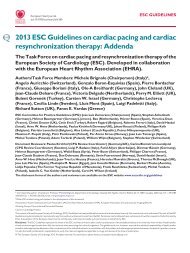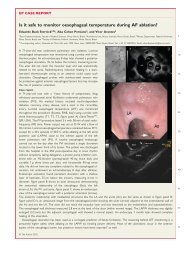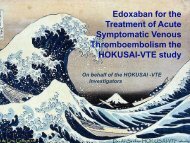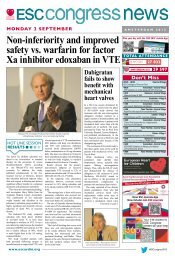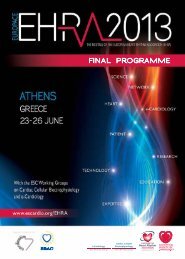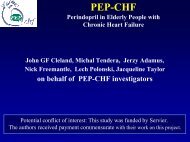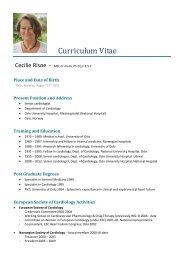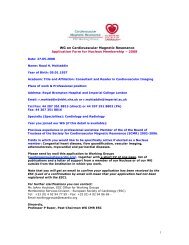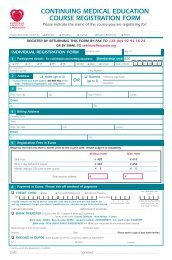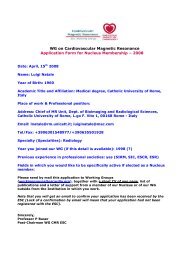EHS on Stable angina - Main publication - European Society of ...
EHS on Stable angina - Main publication - European Society of ...
EHS on Stable angina - Main publication - European Society of ...
You also want an ePaper? Increase the reach of your titles
YUMPU automatically turns print PDFs into web optimized ePapers that Google loves.
The initial management <strong>of</strong> stable <strong>angina</strong> Page 7 <strong>of</strong> 12<br />
Table 5 Clinical characteristics and treatment recommended to patients with planned c<strong>on</strong>servative management or revascularizati<strong>on</strong><br />
from the <str<strong>on</strong>g>EHS</str<strong>on</strong>g> <strong>of</strong> <strong>Stable</strong> Angina<br />
C<strong>on</strong>servative management<br />
(n ¼ 452) % a<br />
n<strong>on</strong>etheless a manifestati<strong>on</strong> <strong>of</strong> cor<strong>on</strong>ary disease, and<br />
should trigger the implementati<strong>on</strong> <strong>of</strong> sec<strong>on</strong>dary preventive<br />
measures. The message regarding the use <strong>of</strong> antiplatelet<br />
agents seems to have penetrated the cardiology<br />
c<strong>on</strong>sciousness to some extent, with 81% <strong>of</strong> patients <strong>on</strong><br />
anti-platelet agents <strong>of</strong> <strong>on</strong>e form or another after cardiology<br />
c<strong>on</strong>sultati<strong>on</strong>, similar to the 83.9% <strong>of</strong> patients with<br />
established cor<strong>on</strong>ary heart disease <strong>on</strong> anti-platelet<br />
therapy in EUROASPIRE II 16 and somewhat less than<br />
reported in c<strong>on</strong>temporary clinical trials <strong>of</strong> patients<br />
with cardiovascular disease. 9 However, with <strong>on</strong>e in five<br />
patients not receiving anti-platelet therapy, this<br />
remains suboptimal. The use <strong>of</strong> statin therapy is even<br />
more disappointing. Only 48% <strong>of</strong> patients were prescribed<br />
statin therapy following review by a cardiologist.<br />
This figure is also similar to the 43% <strong>of</strong> patients with cor<strong>on</strong>ary<br />
disease <strong>on</strong> lipid-lowering drugs at hospital discharge<br />
in EUROASPIRE II, but is c<strong>on</strong>siderably lower than<br />
Revascularizati<strong>on</strong> performed/<br />
planned (n ¼ 501) % a<br />
Male 57 74 58<br />
Diabetic 15 26 17<br />
Age, mean, years 61.2 61.5 61.2<br />
Angina severity<br />
CCS Class I 32 29 39<br />
CCS Class II 53 52 49<br />
CCS Class III 15 19 12<br />
Anti-platelet therapy 88 96 81<br />
Lipid-lowering therapy 48 65 51<br />
Number <strong>of</strong> anti-<strong>angina</strong>l drugs<br />
after cardiology assessment<br />
0 7 3 13<br />
1 23 22 28<br />
2 46 55 42<br />
.2 24 20 16<br />
a Except age; years.<br />
desirable in a patient populati<strong>on</strong> with known or<br />
suspected cor<strong>on</strong>ary disease, and a high prevalence<br />
<strong>of</strong> hyperlipidaemia. Another rather disquieting feature<br />
which emerges from the data is the c<strong>on</strong>siderable internati<strong>on</strong>al<br />
heterogeneity in prescripti<strong>on</strong> practices for<br />
sec<strong>on</strong>dary preventative pharmacotherapy, even in<br />
countries with large volume samples. As an example,<br />
the high average rates <strong>of</strong> aspirin prescripti<strong>on</strong> mask c<strong>on</strong>siderable<br />
variability at nati<strong>on</strong>al level, with prescripti<strong>on</strong><br />
rates varying by up to 50%. The proporti<strong>on</strong> <strong>of</strong> patients<br />
prescribed aspirin ranged from 94% in the UK to 44% in<br />
The Netherlands.<br />
Anti-<strong>angina</strong>l therapy<br />
Overall populati<strong>on</strong><br />
(n ¼ 3779) % a<br />
Table 6 Proporti<strong>on</strong> <strong>of</strong> patients referred for revascularizati<strong>on</strong> (either PCI or CABG) according to recorded severity <strong>of</strong> cor<strong>on</strong>ary<br />
disease from the <str<strong>on</strong>g>EHS</str<strong>on</strong>g> <strong>of</strong> <strong>Stable</strong> Angina<br />
Angiogram planned/performed<br />
but no result recorded<br />
Angiogram performed<br />
with results recorded<br />
0-vessel disease a<br />
1-vessel disease a<br />
2-vessel disease a<br />
3-vessel disease a<br />
Any significant CAD b<br />
n Patients referred for<br />
revascularizati<strong>on</strong><br />
(Total ¼ 501)<br />
753 159<br />
799 342<br />
146 3 2<br />
217 93 43<br />
191 96 50<br />
245 150 61<br />
653 339 52<br />
a Number <strong>of</strong> vessels diseased defined as number <strong>of</strong> vessels with significant cor<strong>on</strong>ary disease.<br />
b Significant cor<strong>on</strong>ary disease defined as .50% stenosis <strong>of</strong> a major epicardial vessel or branch there<strong>of</strong>.<br />
% <strong>of</strong> patients revascularized<br />
according to recorded<br />
severity <strong>of</strong> CAD<br />
In terms <strong>of</strong> specific anti-<strong>angina</strong>l drugs, beta-blockers and<br />
nitrates are clearly the most frequently employed with a





